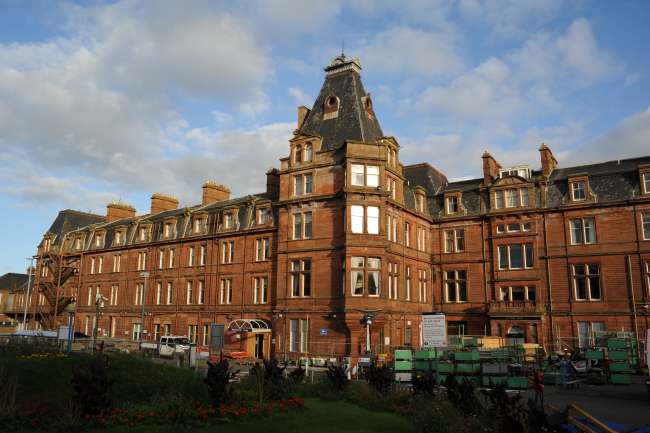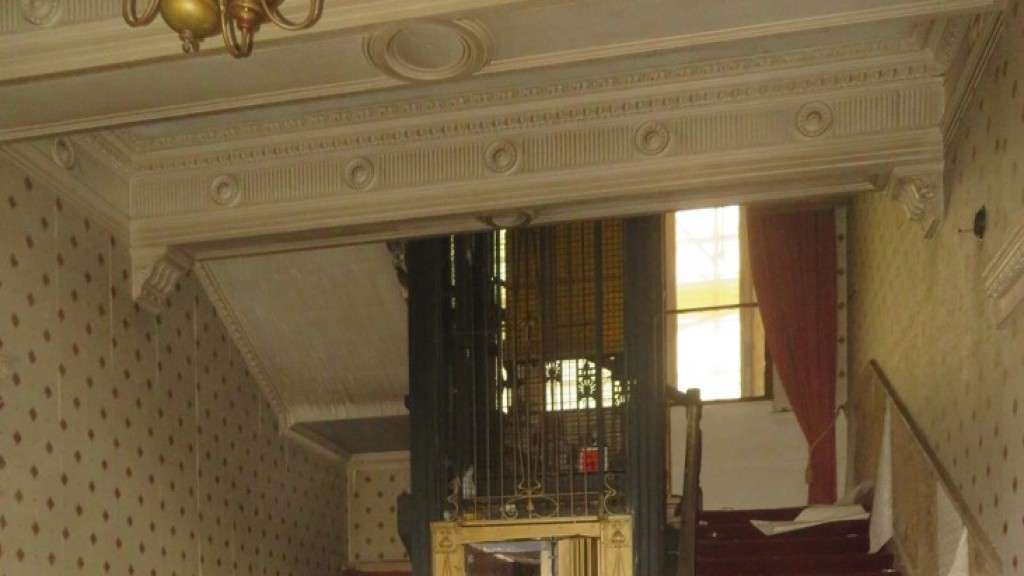PRESS RELEASE: Close-up building survey reveals ‘stunning’ details of Ayr Station Hotel still intact
Specialist building engineer scales the scaffolding at Ayr Station Hotel to establish condition of historic landmark
23rd June 2023
This specialist survey, commissioned by SAVE Britain’s Heritage, marks the first detailed inspection of the Category B listed building in five years and is intended to help facilitate urgent remedial repairs to stabilise the historic structure.
Access to the hotel for Mr Morton’s survey has been facilitated by South Ayrshire Council and represents a major step forward in the campaign to assess the condition of the building and re-use options, having been shrouded in substantial scaffolding since October 2018.
Once complete, the survey will help inform a strategy to secure the structure and remove the scaffolding encapsulation which is currently encasing the South Wing. Mr Morton’s survey will help establish what repairs can be undertaken using this existing scaffold, including fixes to make the roof watertight again and some façade repairs.
Mr Morton’s report on his survey findings will be issued in the coming weeks.
Henrietta Billings, director of SAVE Britain’s Heritage, said: “We are delighted that the detailed inspection has been completed – this is part of a wider ranging plan to help secure a sustainable new future for this landmark building in the centre of Ayr, so that it can once again be the pride of the town. We look forward to sharing the results of Ed Morton’s report.”
Ed Morton, managing director of The Morton Partnership, said: “I am delighted to be surveying this magnificent landmark and it’s been a privilege to be up close to such a vast and historic Victorian structure over the past two days. The hotel was obviously built to exacting standards with no expense spared on architectural details inside and out, from the decorative stone detailing at roof level down to what looks to possibly be the original lift of the 1880s running through the main staircase.”
 2018: View from the south wing in 2018 [Credit: Andrew Milligan]
2018: View from the south wing in 2018 [Credit: Andrew Milligan]
 2023: The south wing today, covered by scaffolding [Credit: ASHAG]
2023: The south wing today, covered by scaffolding [Credit: ASHAG]
Background
SAVE has been campaigning to rescue and bring life back to the hotel since 2016. In August 2022, we published a major report setting out a fundable and sustainable two-stage model to repair and transform this listed building. Our report includes a phased roadmap for repairing the historic structure and the converting it for new use.
Working with local architect Alistair Scott of Smith Scott Mullan Associates, the report sets out five possible options for reuse, ranging from a boutique hotel and events venue to flexible office space and new station facilities. All options include costings undertaken by a professional quantity surveyor and reflect just some of the possible ways of reusing the four storey structure.
The historic hotel was bought in 2014 by a now absentee owner who has failed to maintain the building or respond to enforcement action. As a result, it has since fallen into a state of extensive disrepair, leading to the Council stepping in to encapsulate the building with scaffolding in 2018 to protect the structure and users of the adjoining station.
In December 2022, South Ayrshire Council published a report outlining a series of recommendations for dealing with the hotel. One option included demolition of the historic south wing of the hotel which is both the most recognisable section of the complex, but also contains the most historic interiors.
SAVE strongly objected to this option and our current action is intended to provide all parties with an up-to-date report on the structural integrity of the building – the first such survey for five years – and explore the possibility of using the existing scaffolding to make essential repairs.

View of Ayr in 1927, showing Burns Statue Square and the Station Hotel to the right [Credit: HES]
History
Ayr Station Hotel was designed by the noted Scottish engineer Andrew Galloway in an opulent French Renaissance château-style. He was the chief engineer of the Glasgow and South Western Railway and also designed the Glaisnock Railway Viaduct at Cumnock. The hotel opened in 1885. Its 75 luxurious rooms and lavish facilities catered for an affluent clientele who spent their summer holidays on the Ayrshire coast and attended the town’s fashionable race meetings.
It is constructed in solid Ballochmyle sandstone with handsome stone detailing and is one of Scotland’s grandest station hotels. The pavilion roofs are topped with cast-iron decorations, and the interiors boast many of the original fixtures and fittings, such as the elegant stairs, marble fireplaces and the coffered ceilings.
In total the hotel spans over 350 metres in length, overlooking the station platforms which are covered by an ornate iron and glass roof constructed by Messrs George Smith & Co. of Sun Foundry, Glasgow.
The Station Hotel also included Coffee and Drawing Rooms decorated and furnished by Wylie & Lochhead. Marble, mosaic and tiles for the interiors were provided by Galbraith & Winton, Glasgow, with stained glass by J B Bennett & Sons.
The building’s special architectural and historic interest is reflected by the fact that it was listed (category B) in 1980.

ENDS
Notes to editors
1. For more information contact Ben Dewfield-Oakley, conservation officer at SAVE Britain’s Heritage – ben.dewfieldoakley@savebritainsheritage.org / 020 7253 3500
2. Read SAVE's May 2022 report, Ayr Station Hotel: Proposals for alternative use, HERE
3. See our latest campaign press release from December 2022 HERE
4. SAVE Britain’s Heritageis an independent voice in conservation that fights for threatened historic buildings and sustainable reuses. We stand apart from other organisations by bringing together architects, engineers, planners and investors to offer viable alternative proposals. Where necessary, and with expert advice, we take legal action to prevent major and needless losses

![Ed Morton atop the scaffold in June 2023 [Credit: Morton Partnership]](/img/articles/Image_13.jpg)
![The fully covered roof of the South Wing in June 2023 [Credit: Morton Partnership]](/img/articles/Image_4.JPG)

![The station hotel in 2018 with its magnificent chateaux-like tower [Credit - Nigel Hackett]](/img/articles/Ayr_Station_Hotel,_Ayr,_17_October_Credit_-_Nigel_Hackett1.JPG)